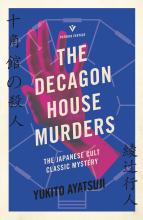The Decagon House Murders, Yukito Ayatsuji
Published in 1978, THE DECAGON HOUSE MURDERS is credited with launching the shinhonkaku movement, a return to Golden Age style plotting and clue provision for the reader to discover along the way. It's often described as a subgenre of the honkaku style - which can best be described as whodunit's rather than why or howdunits. The timeframe of the emergence of both of these styles is particularly interesting, with honkaku mostly considered to have been at its most prolific from the late 1880's to the mid 1950's and shinhonkaku styled novels prevalent from the late 1980s through to around 1997, although examples are still being published today. Perhaps as a result of those distinct timeframes, novels from the shinhonkaku period are normally seen as more interactive or lively, incorporating critical commentary of both itself and other works (or theories / methodologies) commonly deployed in Golden Age works, whereas honkaku is more traditional or conventional in style and execution.
Both of these subgenres of Japanese crime fiction have produced some outstanding and fascinating works, in which the elements described above are clearly visible, and beautifully executed. As is the case with THE DECAGON HOUSE MURDERS which is an absolute mainstay, referred to as "The Japanese Cult Classic Mystery".
The story revolves around a university mystery fan club, where the members adopt the names of famous fictional detectives (Agatha, Orczy, Van Dine, Leroux, Ellery, Carr and Poe), and indulge their interest in fictional and not so fictional murders by way of meetings, outings and conversation.
In this case, the lonely, deserted island of Tsunojima used to have two houses on it. One known as the Blue House, burnt to the ground, with four dead people in it - the owner of the island, his wife, and their staff. Not all of them were alive when the fire started though, and the gardener who should have been there as well hasn't been seen since that night. The Decagon House is still standing, called that because of the shape - inside and out, right down to the crockery and other items within the house. It's weird, but it also seems like a perfect destination for a group of crime-solving-minded young people. There's no power, limited facilities within the house, and a lot of secrets - both in the ruins of the Blue House, the Decagon House and strewn around the island. There is also no way off the island until the boat returns to pick them up - a week after they arrive, and no communication with the outside world.
Meanwhile, back on the mainland, a series of strange letters are leading to something, connected as they are to the island's dead owner, and his daughter. His daughter was a friend of the Mystery Club members, and she's dead as well - not as a result of the fire - and somebody is out for revenge. And nobody on the mainland knows that people on the island have started dying.
Astute followers of Golden Age fiction will instantly recognise that THE DECAGON HOUSE MURDERS was inspired by Agatha Christie's AND THEN THERE WERE NONE. It's cleverly done, with the homage clearly there, but not controlling the motivation, or potential killer's identity. As would be expected from the shinhonkaku style, this is a flat out puzzle, with plenty of clues distributed to allow readers to work alongside the club members as they try to solve the problem before they all die, or the searchers on the mainland to identify the threat and come to the rescue. There's even a finale with everyone in one room as the detective explains what happened and what the clues all were.
Of course this structure brings no particular surprises with it, especially if you're a reader of the Golden Age novels, but the interesting element for this reader was the strong sense of place and culture that it was delivered within. There's something very Japanese about the precision of the Decagon House, and the way that the house and its contents are minimalist, yet hiding much meaning and more. It's an interesting viewpoint to combine everything that happened on the island around the fatal fire, the family that was lost, the lingering doubts about what happened and the missing gardener and connect them via a complex web to some University students and their seemingly harmless club, a week on a deserted island, and the puzzle that they think they are there to solve. Then turning that into a much bigger game being played out around them.
The members of a university mystery club decide to visit an island which was the site of a grisly, unsolved multiple murder the year before. They’re looking forward to investigating the crime, putting their passion for solving mysteries to practical use, but before long there is a fresh murder, and soon the club-members realise they are being picked off one-by-one. The remaining amateur sleuths will have to use all of their murder-mystery expertise to find the killer before they end up dead too.
This is a playful, loving and fiendishly plotted homage to the best of golden age crime. It will delight any mystery fan looking to put their little grey cells to use.
| Review | The Decagon House Murders, Yukito Ayatsuji | Karen Chisholm
|
Tuesday, September 12, 2023 |

